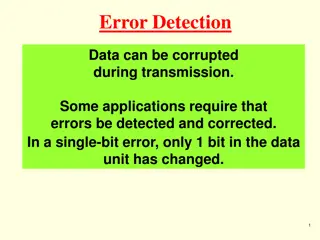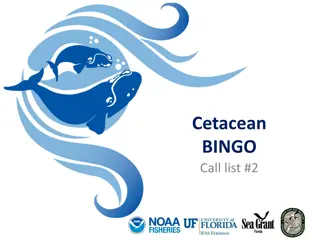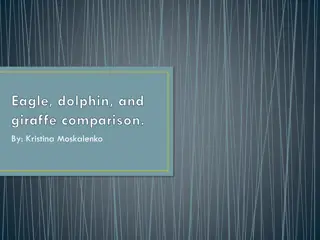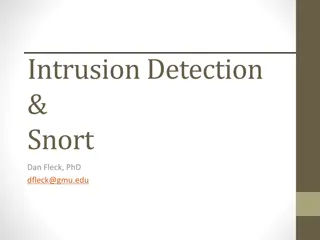Dolphin Burst-Pulses Detection off Cape Hatteras, NC: Biophysical Data Analysis
Detection of dolphin burst-pulses off Cape Hatteras, North Carolina, correlated with oceanographic features using biophysical data analysis. The study highlights the correlation of these bursts with the Gulf Stream position, emphasizing the importance of data management strategies in integrating physical and biological datasets for analysis.
Download Presentation

Please find below an Image/Link to download the presentation.
The content on the website is provided AS IS for your information and personal use only. It may not be sold, licensed, or shared on other websites without obtaining consent from the author. Download presentation by click this link. If you encounter any issues during the download, it is possible that the publisher has removed the file from their server.
E N D
Presentation Transcript
Detection of dolphin burst-pulses off Cape Hatteras, North Carolina, correlated to oceanographic features: Highlighting an approach for biophysical data analysis stephen.lockhart@noaa.gov
Outline 1. 2. 3. 4. Introduction Signals of Interest (Whistles and Quacks ) Correlating Detections with Gulf Stream Position Thoughts Related to Data Management
Introduction Satellite image of sea surface temperature (SST) near Cape Hatteras on March 15, 2015, from Rutgers Coastal Ocean Observation Lab (COOL), using AVHRR. I ve added a star to show the location of our mooring, at a depth of ~230m.
Introduction Instruments on the mooring: AURAL-M2 hydrophone o Sampling under water sound at max rate of 32768 samples/second o Sampling for 5 minutes out of every half-hour CTD o Temperature, Salinity, and Pressure (at the bottom) o Sample interval of 10 minutes Acoustic Doppler Current Profiler (ADCP) o Velocity field (above the mooring) o Acoustic backscatter field (above the mooring) o Sample interval of 10 minutes
Signals of Interest Example of quacks (spectrogram + sound)
Thoughts Related to Data Management Physical data and biological data had different sampling strategies For analysis, the various datasets are tied together by space and time, not by an event
References Baggenstoss P.M. and F. Kurth. (2014). Comparing shift-autocorrelation with cepstrum for detection of burst pulses in impulsive noise. The Journal of the Acoustical Society of America 136, 1574. doi: 10.1121/1.4894734 Beckerle J.C., Baxter L., Porter R.P., and R. C. Spindel (1980). Sound channel propagation through eddies southeast of the Gulf Stream. The Journal of the Acoustical Society of America 68, 1750. doi: 10.1121/1.385220 James R.W. and R.E. Cheney. (1977). Physical characteristics Of ocean fronts and eddies in the North Atlantic. Technical Note 3700-59-77. US Naval Oceanographic Office. Camacho A. and J.G. Harris. (2008). A sawtooth waveform inspired pitch estimator for speech and music. The Journal of the Acoustical Society of America 124, 1638. doi: 10.1121/1.2951592 Jahnke R.A. and J.O. Blanton. (2010). The Gulf Stream. Chaper 3 in Carbon and Nutrient Fluxes in Continental Margins, Springer. Woodworth P.A., Schorr G.S., Baird R.W., Webster D.L., McSweeney D.L., Hanson M.B., Andrews R.D., and J.J. Polovina. (2012). Eddies as offshore foraging grounds for melon-headed whales (Peponocephala electra). Marine Mammal Science 28: 638-647. beta2 version of Silbido from https://roch.sdsu.edu/index.php/software/ swipep implementation in matlab at https://www.cise.ufl.edu/~acamacho/publications/swipep.m Satellite images from Rutgers Coastal Ocean Observation Lab (COOL) at https://marine.rutgers.edu/cool/sat_data/?nothumbs=0&product=sst®ion=capehat























